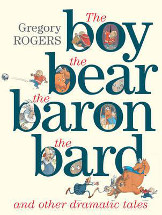The boy, the bear, the baron and the bard and other dramatic tales by Gregory Rogers

Allen and Unwin, 2015. ISBN 9781760112394
(Age: 4+) Highly recommended. Historical, Elizabethan times,
Shakespeare, Medieval knights, Wordless picture book. Gregory
Roger's award winning picture books, The boy, the bear, the
baron and the bard, Midsummer knight and The hero
of Little Street, are offered together in one volume for his
fans and devotees and will attract a new range of readers as
children are introduced to these breathtaking wordless picture
books.
I loved rereading them, recalling discussions with classes in the
past, filling in the detail of Elizabethan England while watching
the boy escape from William Shakespeare. The first story brims over
with enthusiasm for that time in history and children will adore
finding small images which will engender so many more questions,
adding to their historical knowledge. All the trappings of
Elizabethan London are there: bear baiting, the Globe Theatre and
the others on the south side of The Thames, the Queen and her barge
on the river, the man in the tower waiting execution, monkeys in the
street, fashion, housing and so on, a whole world to enjoy as the
boy escapes the Bard's chase.
And with the next story in this mesmerising volume, Midsummer
knight, again held my attention, continuing the story of Bear
and his foray into the castle in the middle of the forest where he
rescues a queen from the dungeons and overcomes her enemies,
restoring her to the throne. Again the detail is glorious; the
background superb in presenting before a young audience the times of
castles and knights, of queens and dungeons, of power struggles.
Bear has been lured into the forest by Puck, the fairy from A
Midsummer knight's dream, and so readers will love deciding to
what extent this is Bear's dream.
The same boy appears in the last story, The hero of Little
Street, where he plays in Trafalgar Square before going into
the National Gallery. Here he falls into a Vermeer panting and lands
in seventeenth century Amsterdam, where he is chased by a pack of
dogs. All the excitement of the chase is there as he evades his
pursuers only to have one follow him out of the painting at the end
with hilarious results. The lustrous illustrations reveal Amsterdam
of the times, and readers will love picking out breadth of the
detail Rogers includes. Historical illustration at its best, I have
enjoyed rereading them immensely and I'm sure new readers and old
will as well.
Fran Knight